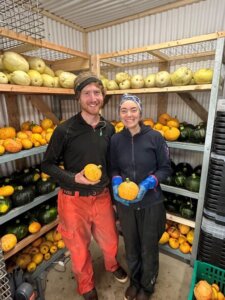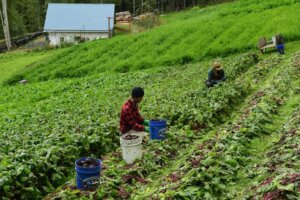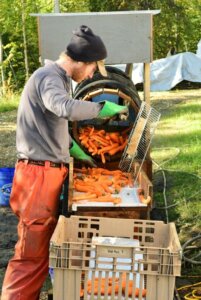By Heidi Rader, Professor of Extension at University of Alaska Fairbanks

Sam Knapp could do anything. He has degrees in physics and chemistry as well as an advanced degree in plant ecology. Yet here he is in Fairbanks, Alaska, making a living growing a wide variety of crops that he stores and sells only in the winter. Oh, and writing about it. I asked him why.
Post-college Sam was working in an office as an engineer and volunteered on a farm on the weekends. He found the weekend work a lot more rewarding than the office work. Climate change mitigation and food security motivate him as well. Although reality has set in and his view of farming is now less idyllic, he still finds the work satisfying, worthwhile and well-aligned with his values.
At Offbeet Farm (https://offbeetalaska.com/), co-owned by wife Danielle Knapp, Sam grows potatoes, beets, turnips, winter squash, kale, garlic, onions, and more. While this may seem like standard locally-grown veggies, what’s different is you won’t see them at the farmer’s market in the summer. But come January, they will have some of the only local produce in town—and you’ll see it up until March.
There are many reasons why Sam focuses on storing vegetables and selling them in the winter. For one, it’s part of his ethos to improve food security. Having local produce in the summer is a piece of the food security puzzle, but what about the rest of the year? He’s also found a wide-open market in the winter for local produce and currently has a wait list for his winter Community Shared Agriculture (CSA) program. Also, he enjoys growing the crops, and enjoys a less harried lifestyle in the summer. Not having to grow and sell the crops at the same time allows him to spread out his workload.

Carving out his own niche as a market gardener storing and selling crops, Sam had to write his own manual which turned into the book, Beyond the Root Cellar: The Market Gardener’s Guide to Growing and Storing Vegetables for Off-Season Sales and Food Security, published last year. This book is nothing if not thorough and well-written. One chapter, entitled “Not Your Grandmother’s Root Cellar” (coined originally by Janaki Fisher-Merritt), sums up much of the idea behind the book, which is essentially to modernize the techniques and facilities used to store produce on a small farm or at home. In his book, Sam shares detailed information on constructing a storage area or building and climate control. For each crop that he grows and stores, Sam writes about choosing varieties, cold hardiness, when and how to harvest the crop, trimming and processing for storage, how to store the crops, as well as common problems. Finally, he shares case studies from real storage farmers that he interviewed.
Sam said he follows the breadcrumbs of cited research back to their sources rather than relying on others’ assertions and interpretations of previously done trials, as we all should do. This is important because many of the conventions for storing crops in a root cellar are based on anecdotal evidence. In addition to using research-based information, he also uses case studies from other farmers, and he meticulously keeps his own on-farm records. Then he takes it one step further and details how he uses research (including his own) in decision making, factoring in practicality as well as the bottom line. He places guard rails on acceptable and ideal storage conditions. The Commercial Storage of Fruits, Vegetables, and Florist and Nursery Stocks, a nearly 800 page USDA handbook, was one of Sam’s favorite resources.

I asked Sam about what some of his favorite varieties were. Choosing a variety for fresh eating is very different than choosing one for its storability. He also chooses ones that excel in organic production. Of course, taste factors in, but the question is, how does it taste after a few months in storage not how it tastes pulled fresh out of the ground. For beets, Subeto is his top pick and for carrots it’s White Icicle. Boleto is known for its storability, but it doesn’t seem to do as well in organic production, so he is looking for an alternative. Many of the crops that store well are direct seeded (beets, turnips, carrots, kale, etc.) or from a seed potato, but winter squash should be started indoors a few weeks before planting out.
In his book, Sam guides us through a decision-making process that pulls from research, on-farm research, practicality, and the bottom line which has utility for all kinds of on-farm decision making beyond storage consideration. Sam provides farmers in Fairbanks, Alaska, and beyond with highly-relevant information for growing and storing crops for most of the winter. He notes that often the most valuable information comes right from your own farm or garden. Sam would love to see more farmers growing and storing food for winter sales, and he’s given would-be storage farmers a jump start with his book.
Questions about gardening or the Tribes Extension Program? Visit www.uaf.edu/ces/tribes Contact Heidi at hbrader@alaska.edu or (907) 474-6620. For more articles like this, go to: https://itgrowsinalaska.community.uaf.edu/
Heidi Rader is professor of Extension in partnership with TCC. This work is supported by the Federally Recognized Tribes Extension Program Project 2022-41580-37957. Any opinions, findings, conclusions, or recommendations expressed in this publication are those of the author(s) and do not necessarily reflect the view of the U.S. Department of Agriculture.
UA is an AA/EO employer and educational institution and prohibits illegal discrimination against any individual: www.alaska.edu/nondiscrimination.
